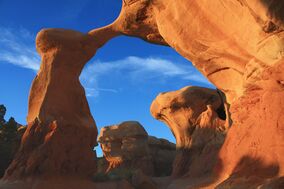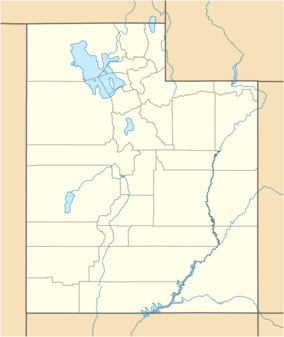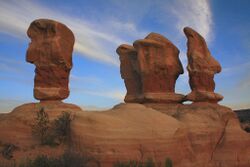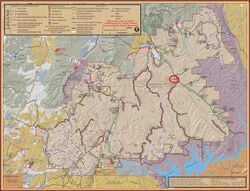Earth:Devils Garden (Grand Staircase–Escalante National Monument)
| Devils Garden | |
|---|---|
 Metate Arch | |
| Location | Garfield County, Utah, United States |
| Nearest city | Escalante, Utah |
| Coordinates | [ ⚑ ] : 37°35′08″N 111°24′53″W / 37.585456°N 111.414671°WUSGS[2] |
| Area | 640 acres (2.6 km2) |
| Elevation | 5243 |
| Designated | December 31, 1979 |
| Governing body | U.S. Bureau of Land Management |
| Official website | |
The Devils Garden[note 1] of the Grand Staircase–Escalante National Monument (GSENM) in south central Utah, United States, is a protected area featuring hoodoos, natural arches and other sandstone formations. The area is also known as the Devils Garden Outstanding Natural Area within the National Landscape Conservation System.[4]
The formations in the Devils Garden were created, and continue to be shaped, by various weathering and erosional processes.[5][6] These natural processes have been shaping sandstone layers formed more than 166 million years ago during the Jurassic period's Middle epoch.[7][8]
The Bureau of Land Management (BLM) administers the Devils Garden and the entire GSENM which is the first national monument assigned to the BLM.[9]
Geography
The Devils Garden is located about 17 mi (27 km) by road southeast of Escalante, Utah.[10] To the west of the area are the Straight Cliffs which define the eastern edge of the Kaiparowits Plateau. To the east of the area is the Escalante River whose tributaries have formed many slot canyons. To the north is the Dixie National Forest and to the south are the Hole-in-the-Rock and Lake Powell which are located within the Glen Canyon National Recreation Area. The Devils Garden is situated at an elevation of 5,243 ft (1,598 m) above sea level in Garfield County, Utah.[2] The area measures 640 acres[11] which is equal to 1 square mile (2.6 square kilometres).
The Hole-in-the-Rock Road is the main access road to the Devils Garden. The unpaved[12] road heads southeast into the national monument beginning at its intersection with Utah Scenic Byway 12 about 5 mi (8.0 km) east of Escalante. After traveling about 12 mi (19 km) along the Hole-in-the-Rock Road there is a road to the right leading to the Devils Garden area.[10] The majority of the interesting sandstone formations are located in a compact area adjacent to the parking lot.[13]
A climate summary and the current weather forecast for the Escalante area are available in the External links section.
Features
Metate Arch[14] is a slender caprock natural arch[15] located near the center of the Devils Garden, while a thicker arch named Mano Arch[16] is located southeast of Metate Arch. Many hoodoos of varying sizes and shapes are scattered throughout the Devils Garden, with a particular group of four prominent hoodoos, with no official USGS name, being a popular photographic subject.[17]
Metate Arch [ ⚑ ] 37°35′4.4″N 111°24′49.5″W / 37.584556°N 111.41375°W
Mano Arch [ ⚑ ] 37°35′3.9″N 111°24′48.5″W / 37.584417°N 111.413472°W
Four hoodoos [ ⚑ ] 37°35′1.6″N 111°24′49.8″W / 37.583778°N 111.413833°W
There are no marked trails but many well-worn footpaths lead to the most interesting formations. Since the Devils Garden is part of a protected area, visitors must not disturb any plants, animals or the delicate biological soil crust. Climbing on or over the natural arches is not permitted by the BLM.[18]
Facilities
Picnic tables and toilet facilities are available.[13] Water is not available and there are no other services provided. Primitive camping is allowed at some points along the Hole-in-the-Rock Road but not at the Devils Garden area or parking lot.[19] A free camping permit is required in advance to camp within the national monument.[20]
Geology
The rock formations of the Escalante area have been designated the Escalante Member of Entrada Sandstone of the San Rafael Group by geologists, and were formed in the Middle Jurassic epoch (166 to 174 million years ago).[7][8] The Straight Cliffs Formation of the Kaiparowits Plateau to the west of the Devils Garden were formed during the more recent Cretaceous period.[21] Paleontologists are interested in the area because the rock formations were deposited when the dinosaurs roamed the Earth. Many dinosaur fossils and tracks have been discovered by scientists working within the boundaries of the GSENM.[22][23][24][25]
The natural arches and other formations were created, and continue to be shaped, by the natural processes of weathering and erosion. Some of the rock layers are composed of a harder caprock material which resists the effects of weathering and erosion. Those caprock layers will remain intact much longer than other less resistant layers which weather and erode away below and around them leaving behind the current arches and hoodoos. Cycles of heat and cold, precipitation, ice, wind and gravity all play a part in the creation of the formations.[5][6]
Daily extreme temperature variations create fractures by repeated expansion and contraction of the rock in a process called thermal stress weathering. The thermal stresses can cause deep cracks that split the rock into separate pieces in an erosional process called thermal exfoliation. Precipitation causes dissolution of the fine crystalline grains that bind the larger particles together, which is known as chemical weathering. Freezing water expands in fractures making them wider and deeper in a process called frost weathering. Gravity exerts a constant downward force that creates new fractures and separates the formations along existing fractures in a process called stress relief exfoliation. High speed winds remove any loose grains from the formations and wind-borne particulates sandblast the surfaces making them smoother.[5][6]
Wilderness
The Devils Garden is also known as a Wilderness Study Area[11] for the purpose of possible wilderness designation; however, wilderness status was not recommended by the BLM's District Manager in an Instant Study Area report[13] submitted to the U.S. Congress in 1991. One of the stated reasons was that the existing roads, parking lot, picnic tables and toilet facilities are all in close proximity to the natural area. A second reason was the likelihood of several groups of people converging at the same time around the main formations of the site, which are located in a 10-acre area adjacent to the parking lot (1.6% of the total designated area of 640 acres). Both of those reasons diminish the wilderness experience of solitude in a remote natural setting.[13]
The Devils Garden remains undeclared as a wilderness area[26] but also remains on a list of BLM Wilderness Study Areas compiled in December 2010.[27]
See also
Major sections of the Grand Staircase–Escalante National Monument:
- Grand Staircase, west
- Canyons of the Escalante, east
- Kaiparowits Plateau, central
Roads and features:
- Utah Scenic Byway 12
- Hole-in-the-Rock Road
- Hole-in-the-Rock formation
Notable explorers:
- Silvestre Vélez de Escalante, name origin of city, river, and monument
- Domínguez–Escalante expedition, skirted but did not enter the monument area in 1776
- San Juan Expedition, traveled through the monument in 1879–80
- Everett Ruess, a young solo explorer of the Escalante Canyons area in 1934
Notes
References
- ↑ "Devil's Garden ISA in United States of America". IUCN. 1996. Archived from the original on May 31, 2018. https://web.archive.org/web/20180531072555/https://protectedplanet.net/devil-s-garden-isa-wilderness-study-area. Retrieved December 31, 2018.
- ↑ 2.0 2.1 "Feature Detail Report for: Devils Garden...Entry Date, Elevation, County and Coordinates". USGS. 31 December 1979. Archived from the original on 8 February 2016. https://www.webcitation.org/6f8fACTOa?url=http://geonames.usgs.gov/pls/gnispublic/f?p%3Dgnispq:3:1288304516310653::NO:3:P3_FID%2CP3_TITLE:1427368%2CDevils%20Garden. Retrieved 14 November 2016.
- ↑ "U.S. Board on Geographic Names - How Do I?". USGS. n.d.. Archived from the original on May 20, 2019. https://web.archive.org/web/20190520031622/https://www.usgs.gov/core-science-systems/ngp/board-on-geographic-names/how-do-i. Retrieved July 18, 2019. "Since its inception in 1890, the U.S. Board on Geographic Names has discouraged the use of the possessive form—the genitive apostrophe and the 's'. The possessive form using an 's' is allowed, but the apostrophe is almost always removed. …Since 1890, only five Board decisions have allowed the genitive apostrophe for natural features."
- ↑ "Feature Detail Report for: Devils Garden Outstanding Natural Area". USGS. 25 February 1989. Archived from the original on 17 June 2022. https://web.archive.org/web/20220617023835/http://geonames.usgs.gov/pls/gnispublic/f?p%3Dgnispq:3:4051689121541550::NO:3:P3_FID%2CP3_TITLE:1435417%2CDevils%20Garden%20Outstanding%20Natural%20Area. Retrieved 14 November 2016.
- ↑ 5.0 5.1 5.2 "Relevant Processes of Erosion ... based on the natural arch formation chapter in reference Barnes, F. A., Canyon Country Arches and Bridges". The Natural Arch and Bridge Society (NABS). Archived from the original on 8 November 2016. https://web.archive.org/web/20161108012106/http://naturalarches.org/archinfo/formation.htm. Retrieved 14 November 2016.
- ↑ 6.0 6.1 6.2 Barnes, F. A. (1987). Canyon Country Arches and Bridges. Canyon Country Publications. p. 416. ISBN 0-9614586-1-5.
- ↑ 7.0 7.1 "National Geologic Map Database, Geolex — Unit Summary". USGS. 3 August 2016. Archived from the original on 14 November 2016. https://web.archive.org/web/20161114042314/http://ngmdb.usgs.gov/Geolex/Units/Escalante_7653.html. Retrieved 14 November 2016. "Escalante Member of Entrada Sandstone of San Rafael Group. Age: Jurassic, Middle"
- ↑ 8.0 8.1 "International Chronostratigraphic Chart". International Commission on Stratigraphy. 1 October 2016. Archived from the original on 11 November 2016. https://web.archive.org/web/20161111055223/http://www.stratigraphy.org/index.php/ics-chart-timescale. Retrieved 14 November 2016.
- ↑ "National Landscape Conservation System". BLM. 21 December 2015. Archived from the original on 30 September 2016. https://web.archive.org/web/20160930174651/http://www.blm.gov/ut/st/en/fo/grand_staircase-escalante/national_landscape.html. Retrieved 14 November 2016. "GSENM is the first national monument to be managed by the BLM and also the first area to be designated as part of the NLCS"
- ↑ 10.0 10.1 "GSENM Travel Map". BLM (PDF file linked from "blm.gov/ut/st/en/fo/grand_staircase-escalante/Recreation/travel_brochure__.html"). 1 March 2016. Archived from the original on 14 November 2016. https://web.archive.org/web/20161114034904/https://www.blm.gov/style/medialib/blm/ut/grand_staircase-escalante/photos/gsenm_visitor_information.Par.44429.File.dat/GSENM_Brochure_map_%202016.jpg. Retrieved 14 November 2016.
- ↑ 11.0 11.1 "Devils Garden Wilderness Study Area". BLM. 1 November 2013. Archived from the original on 4 March 2016. https://web.archive.org/web/20160304050946/http://www.blm.gov/ut/st/en/fo/grand_staircase-escalante/national_landscape/wilderness_study_areas/Devils_Garden.html. Retrieved 14 November 2016. "Size: 640 acres"
- ↑ "Safety Tips". BLM. 24 March 2016. Archived from the original on 4 November 2016. https://web.archive.org/web/20161104002239/http://www.blm.gov/ut/st/en/fo/grand_staircase-escalante/Recreation/safety_tips.html. Retrieved 14 November 2016. "Be Prepared for Poor Road Conditions ... Storms can leave dirt roads impassable for several days"
- ↑ 13.0 13.1 13.2 13.3 "Utah Wilderness Study Report – 1991: Devils Garden Instant Study Area". BLM (PDF file linked from "blm.gov/ut/st/en/prog/blm_special_areas/wilderness_study_areas/ut_wilderness_study.html"). 22 July 1983. Archived from the original on 1 October 2016. https://web.archive.org/web/20161001065940/http://www.blm.gov/style/medialib/blm/ut/natural_resources/nlcs/wilderness_study_areas.Par.51277.File.dat/Devils%20Garden.pdf. Retrieved 14 November 2016.
- ↑ "Feature Detail Report for: Metate Arch". USGS. 25 February 1989. Archived from the original on 8 February 2016. https://www.webcitation.org/6f8ey8PXP?url=http://geonames.usgs.gov/pls/gnispublic/f?p%3Dgnispq:3:3701125397740853::NO:3:P3_FID%2CP3_TITLE:1435934%2CMetate%20Arch. Retrieved 14 November 2016.
- ↑ "Metate Arch". The Natural Arch and Bridge Society (NABS). 1 January 2003. Archived from the original on 10 September 2016. https://web.archive.org/web/20160910053241/http://naturalarches.org/db/nabs/capro3.htm. Retrieved 14 November 2016.
- ↑ "Feature Detail Report for: Mano Arch". USGS. 27 March 1996. Archived from the original on 8 February 2016. https://www.webcitation.org/6f8eqNhSo?url=http://geonames.usgs.gov/pls/gnispublic/f?p%3Dgnispq:3:3701125397740853::NO:3:P3_FID%2CP3_TITLE:1679063%2CMano%20Arch. Retrieved 14 November 2016.
- ↑ "Image search for Devils Garden Escalante hoodoos". https://duckduckgo.com/?q=%22Devils+Garden%22+Escalante+hoodoos&t=canonical&iar=images&iax=1&ia=images.
- ↑ "Rock Climbing and Canyoneering". BLM. 24 March 2016. Archived from the original on 1 October 2016. https://web.archive.org/web/20161001082055/http://www.blm.gov/ut/st/en/fo/grand_staircase-escalante/Recreation/climbing.html. Retrieved 14 November 2016. "Climbing and canyoneering are not allowed in archaeological sites, on natural bridges or arches..."
- ↑ "Suggested Camping Locations by Region". BLM. 1 November 2013. Archived from the original on 11 May 2016. https://web.archive.org/web/20160511232100/http://www.blm.gov/ut/st/en/fo/grand_staircase-escalante/Recreation/camping/suggested_camping.html. Retrieved 14 November 2016.
- ↑ "Permits & Fee Areas". BLM. 24 March 2016. Archived from the original on 1 October 2016. https://web.archive.org/web/20161001082103/http://www.blm.gov/ut/st/en/fo/grand_staircase-escalante/Recreation/permits___fee_areas.html. Retrieved 14 November 2016.
- ↑ "Stratigraphy of the Grand Staircase – Escalante National Monument". USGS. 20 January 2015. Archived from the original on 4 March 2016. https://web.archive.org/web/20160304052046/http://3dparks.wr.usgs.gov/coloradoplateau/escalante_strat.htm. Retrieved 14 November 2016.
- ↑ "New Dinosaur Discovery Unlike any Other". BLM. 13 November 2012. Archived from the original on 1 October 2016. https://web.archive.org/web/20161001073422/http://www.blm.gov/ut/st/en/prog/more/cultural/Paleontology/latest_announcements/new_dinosaurs_09_22.html. Retrieved 14 November 2016.
- ↑ "Celebrate National Fossil Day at Grand Staircase-Escalante National Monument". BLM. 11 June 2012. Archived from the original on 1 October 2016. https://web.archive.org/web/20161001160333/http://www.blm.gov/wo/st/en/prog/more/CRM/national_fossil_day/national_fossil_day.html. Retrieved 14 November 2016. "One of the last great treasure troves of untapped dinosaur fossils in the continental United States lies within Grand Staircase-Escalante National Monument"
- ↑ "Third New Dinosaur Found in Grand Staircase-Escalante National Monument Unveiled". BLM. 21 September 2011. Archived from the original on 29 September 2016. https://web.archive.org/web/20160929024124/http://www.blm.gov/ut/st/en/info/newsroom/2011/september/third_new_dinosaur.html. Retrieved 14 November 2016.
- ↑ "Twentymile Wash Dinosaur Megatrackway". BLM. 4 March 2011. Archived from the original on 12 May 2016. https://web.archive.org/web/20160512140459/http://www.blm.gov/ut/st/en/prog/more/cultural/Paleontology/utah_paleontology/gsenm_paleontology/twentymile_wash_megatrackway.html. Retrieved 14 November 2016.
- ↑ "BLM Wilderness Areas: Detail Table – Wilderness (note: Devils Garden is not listed)". BLM (PDF file linked from "blm.gov/wo/st/en/prog/blm_special_areas/NLCS/Wilderness.html"). 1 December 2015. Archived from the original on 28 September 2016. https://web.archive.org/web/20160928234233/http://www.blm.gov/style/medialib/blm/wo/Law_Enforcement/nlcs/wilderness.Par.56734.File.dat/Wilderness_Q4_2014.pdf. Retrieved 14 November 2016.
- ↑ "BLM Wilderness Study Areas: Detail Table – Wilderness Study Areas". BLM (PDF file linked from "blm.gov/wo/st/en/prog/blm_special_areas/NLCS/wilderness_study_areas.html"). 1 December 2015. Archived from the original on 29 September 2016. https://web.archive.org/web/20160929203254/http://www.blm.gov/style/medialib/blm/wo/Law_Enforcement/nlcs/wilderness.Par.98208.File.dat/WSAs_Q4_2014.pdf. Retrieved 14 November 2016.
External links
- Devils Garden – BLM website
- Current weather forecast – National Weather Service
- Monthly Climate Summary – Western Regional Climate Center since 1901
- Grand Staircase-Escalante National Monument – BLM website
- Grand Staircase Escalante Partners – "committed to preserving and protecting the vast landscape of Grand Staircase-Escalante National Monument"
- The Natural Arch and Bridge Society – "non-profit society supporting the study, appreciation, and preservation of natural arches and bridges"
- Utah Arches photo gallery – images of arches in Utah
 |






